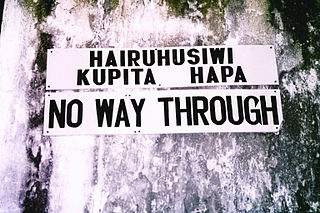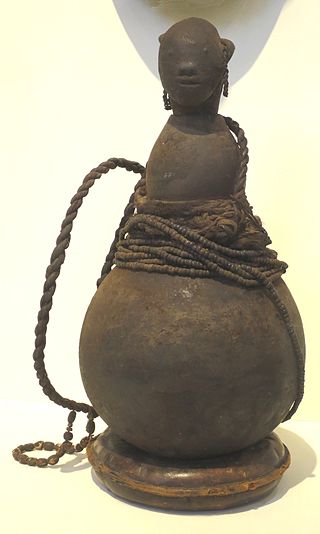
Swahili, also known by its native name Kiswahili, is the native language of the Swahili people, who are found primarily in Tanzania, Kenya and Mozambique. It is a Bantu language, though Swahili has borrowed a number of words from foreign languages, particularly Arabic, but also words from Portuguese, English and German. Around forty percent of Swahili vocabulary consists of Arabic loanwords, including the name of the language. The loanwords date from the era of contact between Arab slave traders and the Bantu inhabitants of the east coast of Africa, which was also the time period when Swahili emerged as a lingua franca in the region. The number of Swahili speakers, be they native or second-language speakers, is estimated to be approximately 200 million.
The Swahili people comprise mainly Bantu, Afro-Arab and Comorian ethnic groups inhabiting the Swahili coast, an area encompassing the Zanzibar archipelago and mainland Tanzania's seaboard, littoral Kenya, northern Mozambique, the Comoros Islands, southwestern Somalia and Northwest Madagascar. The original Swahili distinguished themselves from other Bantu peoples by self-identifying as Waungwana. In certain regions, this differentiation is even more stratified in terms of societal grouping and dialect, hinting to the historical processes by which the Swahili have coalesced over time. More recently, however, Swahili identity extends to any person of African descent who speaks Swahili as their first language, is Muslim and lives in a town on the main urban centres of most of modern-day Tanzania and coastal Kenya, northern Mozambique and the Comoros, through a process of swahilization.

Taveta is the name of a tribe found in Kenya. It is also the name of the principal town in the land of the Taveta people, and the name of the surrounding subdistrict of Kenya.
Mulungu is a common name of the creator deity in a number of Bantu languages and cultures over East, Central and Southern Africa. This includes Yao, Nyamwezi, Shambaa, Kamba, Sukuma, Rufiji, Turu, Ameru and Kikuyu.
Gweno is a Bantu language spoken in the North Pare Mountains in the Kilimanjaro Region of Tanzania. The people known as the Gweno are a Chaga ethnic and linguistic group. Since the Chaga people are Bantu speakers, the adopted language contains dialects similar to that of the Kenyan language Kamba. Gweno shares about 54% to 56% of its vocabulary with other Chaga dialects and 46% with Taita dialects. However, a large percentage of its vocabulary is not seen in the other dialects. Also at the start of the 11th century, the Chaga people descended and migrated from the Bantu group in which they migrated to the foothills of mount Kilimanjaro. The Gweno language is today spoken mostly by older adults, with younger generations having shifted to Asu and Swahili. Ethnologue considers Gweno to be moribund; the language is not being passed down because children have not been exposed to Gweno since the 1970s. The generational shift from Gweno to either Asu or Swahili has certainly created shifts in dialect, however Gweno speakers do not see this as a threat.
Digo (Chidigo) is a Bantu language spoken primarily along the East African coast between Mombasa and Tanga by the Digo people of Kenya and Tanzania. The ethnic Digo population has been estimated at around 360,000, the majority of whom are presumably speakers of the language. All adult speakers of Digo are bilingual in Swahili, East Africa's lingua franca. The two languages are closely related, and Digo also has much vocabulary borrowed from neighbouring Swahili dialects.

The 250 or so "Narrow Bantu languages" are conventionally divided up into geographic zones first proposed by Malcolm Guthrie (1967–1971). These were assigned letters A–S and divided into decades ; individual languages were assigned unit numbers, and dialects further subdivided. This coding system has become the standard for identifying Bantu languages; it was the only practical way to distinguish many ambiguously named languages before the introduction of ISO 639-3 coding, and it continues to be widely used. Only Guthrie's Zone S is (sometimes) considered to be a genealogical group. Since Guthrie's time a Zone J has been set up as another possible genealogical group bordering the Great Lakes.

The Taita people are a Kenyan ethnic group located in the Taita-Taveta County. They speak Kidawida or Kitaita which belongs to the Bantu languages. The West-Bantu moved to the area of the Taita-Taveta County first approximately in 1000-1300.
The Northeast Bantu languages are a group of Bantu languages spoken in East Africa. In Guthrie's geographic classification, they fall within Bantu zones E50 plus E46 (Sonjo), E60 plus E74a (Taita), F21–22, J, G60, plus Northeast Coast Bantu. Some of these languages share a phonological innovation called Dahl's law that is unlikely to be borrowed as a productive process, though individual words reflecting Dahl's law have been borrowed into neighboring languages.
Maʼa is a Bantu language of Tanzania.
Wadawida are a subgroup of the Taita people of South Eastern Kenya in East Africa. These Bantu speaking people are in origin and language more related to the Taveta (Tuweta) people of Kenya, and the Pare who live at the Pare Mountains, Chagga who live on the slopes of Kilimanjaro and Sambaa people of Usambara Mountains in Tanzania.

Tanzania is a multilingual country. There are many languages spoken in the country, but no one language is spoken natively by a majority or a large plurality of the population. Swahili and English, the latter of which was inherited from colonial rule, are widely spoken as lingua francas. They serve as working languages in the country, with Swahili being the official national language. There are more speakers of Swahili than of English in Tanzania.

Lake Jipe is an inter-territorial lake straddling the borders of Kenya and Tanzania. On the Kenyan side, it is located south of the village of Nghonji while on the Tanzanian side, it is situated within Mwanga District, in Kilimanjaro Region. The lake is fed mainly by the Lumi River, which descends from Mount Kilimanjaro, as well as streams from the North Pare Mountains, being on the leeward side. The lake's outlet forms the Ruvu River. Kenya's unfenced Tsavo West National Park protects part of the lake's northern shore, while on the Tanzania side Mkomazi Game Reserve is nearby. The lake is known for its endemic fish, as well as water birds, mammals, wetland plants and lake-edge swamps, which can extend 2 kilometres (1.2 mi) from Jipe's shore.
Taita is a Bantu language spoken in the Taita Hills of Kenya. It is closely related to the Chaga languages of Kenya and Tanzania. The Saghala variety is distinct enough to be considered a language separate from the Daw'ida and Kasigau dialects.
Vidunda (Chividunda) is a Bantu language spoken along the north bank of the Ruaha River in Tanzania. It belongs to the Ruvu branch of Northeast Coast Bantu.

The boundaries of this corridor can be defined within the Maasai territory. The corridor stretches from the Arusha Region, through the Kilimanjaro Region of Tanzania to the Taita-Taveta County of Kenya. To varying degrees, the people in this corridor are essentially a mixture of similar Bantu, Nilotic and Cushitic branches of the African people. The groups were dynamic, fluid and flexible. They shared a common history characterised by constant movement between the different areas for trade, battles, migration as well as social reasons. They were categorised arbitrarily by Europeans into the following culturally, linguistically and/or genetically related groups:

The Mbugu people, also known as the Va'maa, Ma'a are an ethnic and linguistic group hailing from western Usambara Mountains of Lushoto District in Tanga Region of Tanzania. Tanzania's Mbugu language is one of the few true hybrid languages, combining Bantu grammar with Cushitic lexicon. In actuality, the people speak two languages: one mixed and the other Pare, which is closely linked to the Bantu language. They are estimated to be around 60,000 Mbugu people left.







